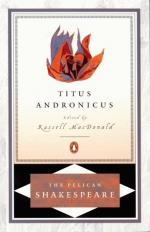|
This section contains 3,993 words (approx. 14 pages at 300 words per page) |

|
SOURCE: “The Forest, Hunting and Sacrifice in Titus Andronicus,” in New Perspectives on the Shakespearean World, translated by Janet Lloyd, Cambridge University Press, 1985, pp. 40-47.
In the essay below, originally published in 1981, Marienstras demonstrates the way in which Titus Andronicus uses the violence that occurs in the name of hunting and sacrifice to explore the dichotomy between “civilized” Rome and the “wildness” of nature.
Shakespeare's interest in the themes of hunting, the forest and sacrifice—or the sacrificial act insofar as it can be represented or evoked on stage—can be clearly seen in Titus Andronicus.1
While Saturninus and Bassianus are engaged in a struggle for power, Titus makes his triumphal entry into Rome. He has conquered the Goths and brings back prisoners with him: Tamora, queen of the Goths, her three sons Alarbus, Chiron and Demetrius, and Aaron the Moor. Alongside four living sons, he also brings...
|
This section contains 3,993 words (approx. 14 pages at 300 words per page) |

|


